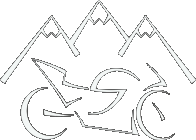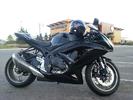I live in deer country. I can take a ride during late August and can easily see over 200 deer in a few hours. Riding in early morning or late evening pretty much guarantees that I'll see at least one deer on any given day. These are my findings. 1) Nothing is for sure with regards to deer. 2) Driving by without making any changes, no throttle change, no speed change, no swerve, will 90% of the time at most make the deer raise its head to look at you. 3) The other 10% of the time is the problem. 4) Deer can be anywhere at any time. 5) Deer get little traction on asphault. 6) Horns make deer panic, go insane, or do any number of really stupid things, including the cartoonish start to a run, where all legs and hooves are flying every-which-way and no progress is made for the first five seconds. 7) If you see a deer cross in front of you, pay particular attention to its eyes and ears. If it looks back or if its ears are pointed back, there is almost certainly another one following. Don't look at the deer that crossed, scan for others. (target fixation can get you here)Make use of your emergency stopping technique. (always know if someone is close behind that may run you over... it IS their fault, but it IS your body that loses) The best cure is to scrub off as much speed as possible. Since you don't know about the 10% problem, the only way to play the roulette game is to bail out of the game... slow down fast! If the deer is in the road.. don't swerve, put all of your usable traction into slowing down, not swerving, as you have no idea where the deer will be once you are upon it. If you do, could you please send me some lottery numbers? I feel the best odds of surviving is to take the hit straight up. I know a 'lot' of people who have hit deer and never gone down. I know only a few that went down. I know of several who went down trying successfully missing the deer, but were worse off than hitting the deer. The slower you are going, the less the impact force. 9) Don't follow your buddy too close in deer country. Give him plenty of room to use the emergency stop. 10) If the deer is suddenly there, and you have no time to slow down, make no changes and pray that it will be one of the 90% deer and not be concerned with you. 11) Practice your emergency braking before you need it and do it often. 12) Deer hunt as often as possible and/or lobby for longer seasons or more tags.
Today I met a Buck and this dude was huge while riding in the mountains...i had just started to hit the twisties and i was feeling them. I am very grateful for the thoughts that were in my head at that splint second....ease on the brakes...I didnt panic..I just applied the brakes. I bring this up because I learned this in the Sunset Safety Clinic..and we also practiced it I think for about 3 hours, that was enough to make it stick.






 Reply With Quote
Reply With Quote